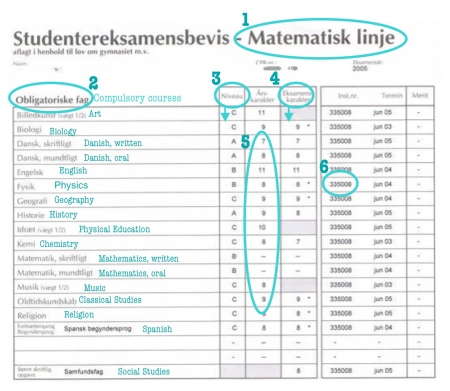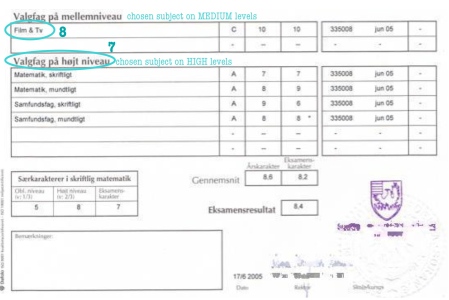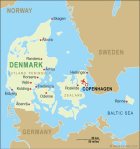For the next several weeks, we’ll look at report cards from around the world.
~ Pack Your Coats! ~
~ Third Stop ~ Sorø ~
.
.

Sorø, a small town of 7,708, rests on the island of Zealand in the Kingdom of Denmark. Home to Sorø Akademis Skole (Sorø Academy), the second oldest school in Denmark, Sorø is also a popular residential area for those who work in Copenhagen, the capital city.
The Danish government values education, providing compulsory education free of charge, which results in a 99% education rate for both men and women. About 82 % continue formal education after Flolkeskole (public school), often at one of the public universities.
.

Final Report Card Basics
- Type of School: Local, Danish school
- Academic Years: 2002 – 2005
- Class: 1st to 3rd grade* (equivalent to 11th to 13th grade)
* In Denmark, high school consists of three years, called 1st, 2nd and 3rd, though this is not to be confused with elementary school.
.
Here’s the report card! The blue circles highlight a few interesting aspects of the report and the numbers correspond to notes below the image.
Hint ~ If you are having trouble viewing the report card, try the Zoom function under your browser’s View tab.

1. Matematisk Anyone?
Secondary students attend Gymnasium after 10th grade (no, not the kind of gym you exercise in, but a secondary school, comparable to English grammar schools or U.S. college-prep high schools). Pupils must choose a studieretning or a “line of study,” which usually includes mathmatical or linguistic streams.
2. Obligatoriske fag ~ Compulsory Courses
Like most students around the world, Danish students must take their local language (Danish), math and science, but they have some unique required courses as well, including geography, religion and classical studies (which focuses on the Greek and Roman civilizations).
3. Niveau ~ A, B and C Levels
This may look like the student’s grades, but in fact they are levels. Students may take classes at A, B or C levels (A being the highest). This student explains that many of the C-level courses were mandatory and taken within the first year. Does anyone know of another system that offers 3 levels? (Advanced Placement and International Baccalaureate offer 2 levels…)
4. Oh dear! I got a -3 in Geography!
This report card shows an older version of the Danish grading system, the current grading scale is based on 12 points, although negative points are possible too. Here’s a chart of the “Marking Scale.”
| -3 | For an unacceptable performance. |
| 00 | For an inadequate performance. |
| 02 | For an adequate performance. |
| 4 | For a fair performance. |
| 7 | For a good performance. |
| 10 | For a very good performance. |
| 12 | For an excellent performanc |
5. Eksamens-karakter ~ Exam grade
This report card shows both the class grade, as well as an exam grade, however students do not take an exam for every course. At the end of the year, students choose three or four courses in which to complete an exam. Compare this to India’s education system, which is primarily based on tests!
6. Gymnasium 335088
Danish schools receive an institution number, which helps the national education system run smoothly in terms of file sharing and data base maintenance. This demonstrates unity of the public school system, largely a centralized, federal institution.

7. Specialized Study
Students choose a specialized study program of three courses, usually of 2 high level (A-level) and one medium level (B-C level) courses. Of course, the gifted student may choose to take three high level courses. This student choose matematik (math), samfundsfag (social studies) and Film and TV.
8. What did you study in TV class today?
Students may also choose shorter elective courses in the last year, including: psychology, geography, astronomy, Greek and more. This student chose TV and Film. Here’s her explanation of the class, and film in Denmark.
“I was really interested in Film and TV and it’s a strong growing business, not only in Hollywood. In fact, Denmark is the one country in Europe that releases the most movies a year and we are really good at making low-budget movies.
In class, we would watch movies, analyze and critique them. We would talk about different genres, lighting, camera work, etc., and then make our own little films. We would write scripts, draw story boards, act, direct, shoot and edit. And then, in complete agony, show them to the whole school at morning assembly!!!
It’s just one of those courses that are made to help kids figure out what they want to do. I found it super interesting and now it’s what I want to do. There are some who found out it wasn’t something for them, and are doing completely different things today.”
See Report Card from: Kathmandu, Nepal; Dalhousie, India
Report card analysis to look forward to: Malawi, Australia, Canada, Mexico and more!


[…] See Report Card from Dalhousie, India; Soro, Denmark […]
please show name off school n student name ok
thanks
Unfortunately that information cannot be shared to protect the person’s privacy. Thanks for your comment though!
Hi, I was searching for Denmark images and accidentally found this insightful report (even having been in Denmark for many years now). I have always appreciated the educational system in Denmark where there is a lot of freedom for students to try out different things. The feedback provided by a student in Film and TV class really demonstrates that 😉 Loved it! By the way, here is the new grading system in Denmark. I was lucky to have tried both. (they introduced it on the last year of my studies).
7-point grading scale
12
Excellent (A ECTS)
For an excellent performance dis- playing a high level of command of all aspects of the relevant material, with no or only a few minor weaknesses.
10
Very good (B ECTS)
For a very good performance dis- playing a high level of command of most aspects of the relevant material, with only minor weak- nesses.
7
Good (C ECTS)
For a good performance dis- playing good command of the relevant material, but also some weaknesses.
4
Fair (D ECTS)
For a fair performance displaying some command of the relevant material, but also some major weaknesses.
02
Adequate (E ECTS)
For a performance meeting only the minimum requirements for acceptance.
00
Inadequate (Fx ECTS)
For a performance which does not meet the minimum require- ments for acceptance.
-3
Poor (F ECTS)
For a performance which is unacceptable in all respects.
Thanks for your comment Vladimir! How interesting. Which system did you prefer?
@ findingschools, thanks for the interaction.
I think I only tried the new system for one year, so it would not be fair to say which one “beats” the other. I do get an impression that it does not really matter in evaluating student’s performance – new or old system, it really does the same thing. I think maybe because I was used to 13 point system and can relate to that a bit more, but other than that I really had no preference as such 😉
fantastic points altogether, you simply received a new reader.
What would you recommend about your publish that you just made a few days ago?
Any certain?
Howdy! I could have sworn I’ve been to this website before but after reading through some of the post I realized it’s new to me.
Anyways, I’m definitely glad I found it and I’ll
be bookmarking and checking back often!